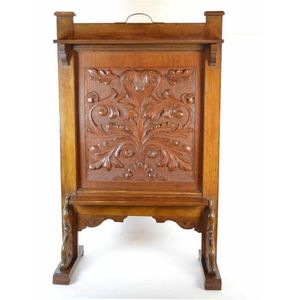Rosewood Liqueur Cabinet on Stand with Peacock Carvings
You must be a subscriber, and be logged in to view price and dealer details.
Subscribe Now to view actual auction price for this item
When you subscribe, you have the option of setting the currency in which to display prices to $Au, $US, $NZ or Stg.
- Paw Feet - A paw foot is a base of a furniture leg that resembles the paw of an animal, such as a lion or bear. It is a decorative feature that is often seen in traditional furniture designs, particularly in styles such as Chippendale, Queen Anne, and Georgian. A paw foot typically consists of a carved or moulded ball or disk at the bottom of the leg, which is then carved or shaped to resemble the toes or claws of an animal. The foot may be smooth or textured, depending on the design, and may be finished in a variety of materials, such as wood, metal, or even marble.
Paw feet are often used on heavier pieces of furniture, such as chests, tables, and chairs, to provide additional stability and support. They are also used as a decorative element, adding a touch of elegance and sophistication to the overall design.
"Hairy paw feet" is a term used to describe a variation of the foot design that features a carved or sculpted animal paw, such as a lion or bear, with hair or fur details. The hair or fur details were often carved in a realistic manner and added to the overall decorative effect of the furniture. Hairy paw feet were commonly found on furniture items such as tables, chairs, and cabinets and were popular in the 18th century. - Panels - Timber pieces, usually of well-figured wood either recessed or applied over the frames of doors and as decoration elsewhere in the carcase of cabinet furniture. The panels may take a variety of shapes rectangular, square, shield shape, oval, half-round or in the form of Egyptian pylons.
- Cabriole Leg - The cabriole leg evolved from an elongated scroll, curving out at the knee which may or may not be carved, and forming a serpentine shape as it descends to the foot.
First introduced into English furniture in the late 17th century, cabriole legs were widely used during the Queen Anne and early Georgian periods, where they frequently terminated in a pad foot or ball and claw foot. The style has had many imitators since then. The cabriole leg was re-introduced in the mid-19th century, and is commonly associated with the balloon-back dining or drawing-room chairs made in walnut, mahogany or, in Australia, cedar. The Victorian cabriole leg, on the whole, was rather more slender than the earlier form, following the French style, which emphasized the delicacy and daintiness of the chairs they were designed to support. Cabriole legs are sometimes found on windsor chairs, especially those made during the 18th century. - Circa - A Latin term meaning 'about', often used in the antique trade to give an approximate date for the piece, usually considered to be five years on either side of the circa year. Thus, circa 1900 means the piece was made about 1900, probably between 1895 and 1905. The expression is sometimes abbreviated to c.1900.
- Rosewood - A dense timber that varies in shade to very light brown to almost black. When rosewood is cut and sanded the colour of the timber will turn black, and after polishing and exposure to daylight, the surface will gradually lighten over time to light brown with black streaks.
The name comes from the odour emanating from the timber when it is planed, sanded or cut.
Rosewood was very popular for use in Victorian furniture in the second half of the 19th century, and at that time most of the rosewood was imported from Brazil. However it also grows in India and Indonesia.
It is used in the sold for chairs and table legs, but for carcase furniture such as side cabinets and bookcases, and for table tops it is always used as a veneer.
This item has been included into following indexes:
Visually similar items

A West Australian Arts & Crafts style jarrah and Sheoak fire screen, early 20th century school of William Howitt (1846-1928), probably by one of his students the central sheoak panel decorated with carved acanthus leaves and scroll motifs. Height 83 cm, wi

A Italian polychrome two door cabinet, 19th century, the serpentine cabinet hand painted in a deep green ground and decorated with floral scroll motifs. Each door decorated with a central reserve featuring a romantic scene of a young female beauty, one hol

Baroque hall seat, heavily carved back, oak with storage compartment

An oak music cabinet, early 20th century, having a galleried back and a single cupboard with a foliate and lyre carved panel enclosing a partitioned interior for sheet music, shaped and flared side supports with channel grooving to curvaceous legs, height
